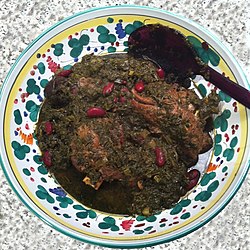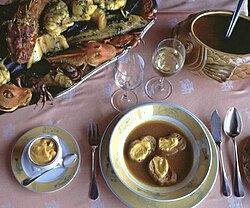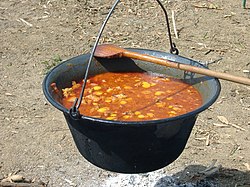 Lamb and lentil stew | |
| Type | Stew |
|---|---|
| Place of origin | Worldwide |
| Region or state | Unknown |
| Main ingredients | Vegetables (carrots, celery, parsnips, potatoes, onions, beans, mushrooms, etc.), meat (such as beef), and a liquid such as water, wine, beer or stock |
A stew is a combination of solid food ingredients that have been cooked in liquid and served in the resultant gravy. Ingredients can include any combination of vegetables and may include meat, especially tougher meats suitable for slow-cooking, such as beef, pork, venison, rabbit, lamb, poultry, sausages, and seafood. While water can be used as the stew-cooking liquid, stock is also common. A small amount of red wine or other alcohol is sometimes added for flavour. Seasonings and flavourings may also be added. Stews are typically cooked at a relatively low temperature (simmered, not boiled), allowing flavours to mingle.
Contents

Stewing is suitable for the least tender cuts of meat that become tender and juicy with the slow, moist heat method. This makes it popular for low-cost cooking. Cuts with a certain amount of marbling and gelatinous connective tissue give moist, juicy stews, while lean meat may easily become dry.
Stews are thickened by reduction or with flour, either by coating pieces of meat with flour before searing or by using a roux or beurre manié , a dough consisting of equal parts fat and flour. Thickeners like cornstarch, potato starch, or arrowroot may also be used. Stew is very prominent in England, with beef stew and dumplings having been one of England's national dishes in the 14th century. Other European countries also have their own recipes.

















